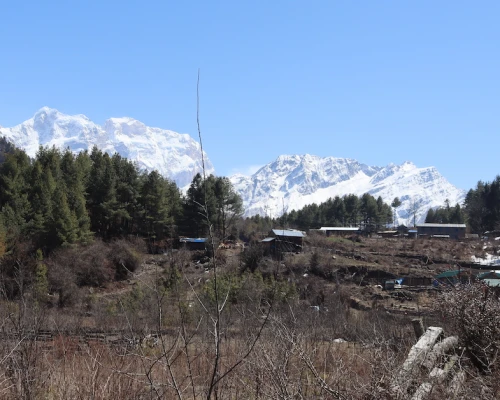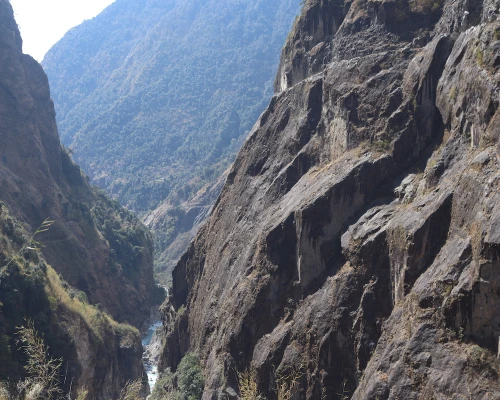There is a less trodden route for the Annapurna Nar Phu Valley and Tilicho Lake trek, as Nar Phu Valley only opened to trekkers in 2003. The area still remains less trekked and requires a special pair to enter for every traveller. The trails leading trekking to the Nar Phu and Tilicho lake areas explore remote villages, forests, Tibetan-like peoples, and Buddhists as it is stitched just off the Annapurna Circuit route.
The trail of our Nar Phu and Tilicho Lake Trek leads to the steep entrance of the Nar Phu Valley, which can easily be overlooked via a bridge spanning the Marshyangdi River. Likewise, beyond this narrow, forested "entrance," a completely different world awaits the trekkers.
Regarding the trekking time around the region, the duration of each day's trek is not as long as in some other routes, and completing 5-6 hours of hiking can be pretty challenging. But still, having a good fitness level will benefit the trekkers and the previous trekking experience.
Our Annapurna Nar Phu Tilicho trek offers a unique and less-traveled route in the Annapurna region, perfect for adventurous trekkers who want to explore remote areas of Nepal beyond the usual trails. This trek, which includes tea house accommodations, showcases the picturesque landscape of the recently accessible Nar and Phu Valley, situated north of the renowned Annapurna circuit route.
In addition, the topography of Nar Phu Valley resembles that of Tibet, creating rugged trails that have remained unchanged over the years. During this trek, we will spend several days exploring this secluded valley and cross theKang La pass (5,300m) on our way to Manang.
The Nar Phu and Tilicho Lake Trek is an exceptional and lesser-known journey in the Annapurna region, leading through the hidden Nar Phu valley—an area that was opened to foreign visitors only in 2003 and is known as the habitat of Snow Leopards and Himalayan Thars. This trek offers a captivating experience of the unique culture found in Nar Phu and breathtaking views of majestic mountains in the highlands. Along the way, we will encounter Bhote communities, visit beautiful medieval and ancient remote villages, witness fantastic rock formations and glaciers, and traverse several passes, narrow canyons, and lovely forests. We will also have the opportunity to explore old Tibetan Buddhist monasteries and immerse ourselves in the distinct Himalayan and Tibetan cultures. This off-the-beaten-path adventure is perfect for those seeking to venture into Nepal's less-explored and isolated regions, away from the regular trekking routes.
We will discover the hidden treasures of Nar Phu Valley, cross challenging high passes like Kang La and Meso Kanto, and visit the world's highest lake, Tilicho. Located north of Annapurna, the Nar Phu Valley, along with the Tilicho Lake, is a wild and unexplored region with Tibetan villages, recently opened for trekkers in the early 20s.
Therefore, if you're craving to experience the majestic allure of the Annapurna region, with its towering snow-capped peaks and pristine beauty, while also desiring a less travelled path to travel to, then the Nar Phu Valley with Tilicho Lake trek could be a perfect choice to begin your journey with.
Summary Of NAR PHU AND TILICHO LAKE & THORONG LA PASS
The Nar Phu Valley trek and Tilicho Lake trek together combined a distinctive spin of the popular route called the Annapurna Circuit trek. Starting by foot from the Buddhist communities of Nar and Phu villages in the Tibetan plateau discloses an extraordinary chance to witness various wonders.
To explain more in detail, this expedition encompasses everything from the remarkable wildlife flourishing in the Annapurna conservation area to the age-old villages steeped in history. Trekkers will be captivated by the breathtaking mountains, majestic glaciers, serene lakes, and vibrant tapestry of cultural traditions that enrich the region.
This challenging yet beautiful journey takes the trekkers to the lesser-explored region of Nar and Phu valleys, where the hidden treasures await. Along the way, you'll encounter Tilicho, one of the world's highest-altitude lakes, sitting at an impressive elevation of 4919 meters. Likewise, This unforgettable trek offers a blend of off-the-beaten paths, breathtaking mountain vistas, remote Tibetan villages showcasing their unique culture, high mountain passes, serene Buddhist monasteries and gompas, vibrant prayer flags fluttering in the wind, and a rich tapestry of diverse flora and fauna.
While the journey may demand physical endurance, particularly during the challenging Kang La Pass and Thorong La Pass sections, the magnificent panoramas of the Annapurna massif, Lamjung Himal, Dhaulagiri range, Manaslu Himal, Tilicho Peak, and other majestic peaks make it all worthwhile, rewarding your efforts with a sense of fulfillment.
The 19-day Nar Phu Tilicho Lake Trek starts from the low altitude place Jagat, passing through Besi Sahar and outlining the renowned Annapurna Circuit trail until Koto. From Koto, you divide into a pine forest, venturing northeast into the Annapurna region, following the Naarkhola route to reach Phu via Meta. Rejoining the Annapurna circuit at Ngawal, you traverse the captivating landscapes of Nar and the challenging Kang La Pass, eventually arriving at Khangsar through Manang. The journey takes you to Tilicho Base Camp before ending in Jomsom, crossing the fascinating Thorong La Pass.
What Do You Expect On The Trek
Our main objective for this journey revolves around exploring the Nar Phu Valley, Thorong La Pass, and Tilicho Lake. While trekkers are open to hiking all commonly frequent certain parts of this route, we will experience several days without encountering other fellow hikers, particularly in the remote Nar/Phu Valley. Breathtaking landscapes are a guarantee throughout this journey. However, what different experiences can you truly expect with this trek?
It Will be Very Physical
During the trek, you will have to do extensive hiking. This means you should be prepared for hiking durations ranging from 4 to 9 hours per day, navigating diverse terrains such as steep hills, elevated suspension bridges, and rocky pathways in the Annapurna region.
You may have heard calling many routes Nepali flat but don't be fooled, as they still involve rugged terrain, less steep than others. Still, your physical effort will be handsomely rewarded as you constantly encounter breathtaking vistas of Nepal's awe-inspiring scenery while trekking.
Back to Basics
The trek to Nar Phu Valley and Tilicho Lake Trek offers basic yet fine food and accommodation. The tea houses along the route present similar food options, such as dumplings, noodles, soup, and rice with curry and vegetables (dal bhat). Although the menu might become repetitive, the high-carbohydrate meals will provide the necessary maintenance for your time. Still, avoid consuming meat as it might not be fresh in high-altitude areas.
The rooms normally feature a basic bed with a pillow; some teahouses may provide a blanket. However, bring a good quality sleeping bag to stay warm during cold nights. In addition, shared bathrooms with squat toilets are standard, and you'll quickly become proficient in using them.
Lifetime Memories
The physical discomforts and aches from your journey will gradually fade away, yet what you will endure are priceless recollections unlike any other. The bonds formed with fellow travellers and guides are often fast and deep. Likewise, the Himalayas' grandeur and the Sherpa community's warm-heartedness remain in your heart indefinitely. When you recall hiking to Nar Phu and Tilicho Lake in Nepal, a feeling of success and joy will accompany those reflections with a warm friendship with Mountain Rock Treks.
Typical Day in Nar Phu Valley Trek
Unless you opt for camping, each night (and many lunches) will be spent at tea houses. These cozy locations along the Annapurna Circuit cater specifically to trekkers. Since we travelled during the off-peak season, many of these tea houses were closed during our visit.
At the beginning of our trek, the weather was generally warm due to the lower altitude, although we were ascending most of the time. Our typical routine consisted of having breakfast at a tea house, followed by a few hours of trekking. We would take a tea break, usually at another tea house, continue trekking for a few more hours, and then pause for lunch and a brief rest. Similarly, depending on our planned distance for the day, we would continue our journey in the afternoon, ultimately reaching our destination and locating a tea house. Once there, we would unpack, relax, enjoy dinner, and finally settle in for the night.
Along our route, the number of fellow trekkers was scarce, and upon reaching the Nar/Phu Valley, the sightings became even more infrequent. There will be sections where internet access is nonexistent, with satellite phones or services being the only option. Additionally, some tea house owners may be pleasantly surprised to have you as their guests.







